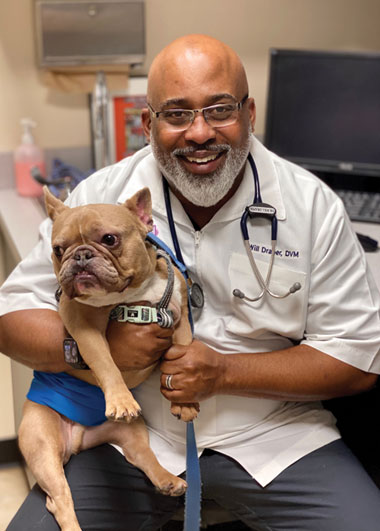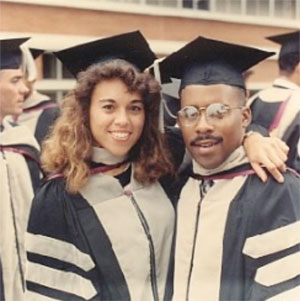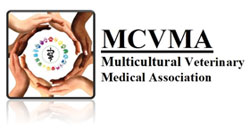
July 15, 2020
Veterinarians talk racial discrimination
Dr. William Draper and his wife, Dr. Françoise Tyler, have been successful by any measure. They founded The Village Vets, one of the largest privately owned groups of veterinary hospitals in the metro Atlanta area. They have their own TV show, “Love & Vets,” on Disney+. And they have four children, one of whom is heading to law school and another who is studying neuroscience at Georgia Tech.

But Dr. Draper can also tell you about the challenges and racism he has faced as a Black man raised in Inglewood, California, who has practiced in the South for nearly 30 years.
In the mid ’90s, he once had a client refuse to see him. The client said his dog “ain’t seein’ no colored doctor,” even though his small dog was suffering from congestive heart failure and needed immediate care. Dr. Draper was able to convince the older white man to let him stabilize the dog, Tiny, which the client reluctantly did. The client would go on to request Dr. Draper for the remainder of Tiny’s life and insisted Dr. Draper be the one to put Tiny to rest.
And then there was the time early in Dr. Draper’s career when a white practice manager said to him, after a dog Dr. Draper was examining growled at him, that it was likely “due to the fact that Black people have a smell that’s different than white people.”
Dr. Draper attended Tuskegee University, a historically Black university where his grandfather had worked and Dr. Draper had completed his undergraduate studies, following behind his parents, maternal grandparents, and maternal great-grandmother. He and his wife, who is also Black, graduated from Tuskegee with their veterinary degrees in 1991. He said even then, other institutions rarely admitted minorities. Now, he said, things have improved, at least in regard to institutions admitting minorities. In the general population, he’s not so sure things have improved—and as the father of a Black son and three Black daughters, that concerns him greatly.

“I have a great life; I love my job, and I love Atlanta. I have clients of all colors, and they are, as a whole, amazing, caring people. I’m as fortunate as anyone I know, but I do see chinks in the armor of our communities and the world that worry me,” Dr. Draper said. “That I have to look at a video of a Black man being killed with a knee on his neck in 2020—that’s blatant racism. I don’t know why it’s still happening in this day and age.”
Shining a spotlight
On May 25, George Floyd, a Black man, was killed in Minneapolis. During an arrest, Derek Chauvin, a white police officer, kept his knee on the side of Floyd’s neck for almost nine minutes while Floyd was handcuffed and lying face down.
Video of Floyd’s death circulated widely in the following days, leading to widespread protests—eventually spreading to all 50 states as well as worldwide—with demonstrators calling for an end to police violence. The incident has also caused many white individuals to recognize and take a greater interest in fighting racial discrimination and inequality. For people of color, the fight is nothing new.
“The United States has a track record of historically and systemically disadvantaging certain racial groups,” states the American Medical Association, adding that racism and police brutality detrimentally impact the health of Black communities. During a June panel discussion, Dr. Aletha Maybank, the AMA’s chief health equity officer and vice president, said structural racism causes emotional and mental harm, explaining, “Sustained exposure to racism in all of its forms increases our stress hormones, such as cortisol, which causes havoc on our physical bodies.”
For better or worse, what’s happening in the U.S. has spotlighted what needs to change in the profession, too. It’s not enough to stand by and be silent and say, ‘It’s not right, but it’s not happening here.’ Everybody has to speak up and take action, or else nothing will change.
Dr. Christina Tran, president, Multicultural VMA
The National Association of Black Veterinarians is among a handful of organizations working to increase diversity and inclusion in the veterinary profession and colleges. Its founder, Dr. Annie Daniel, told JAVMA News last year, “We believe that now is the time to bring attention to the fact that the numbers of Blacks in the profession have not increased in decades. … Our research over the past almost 10 years shows that diversity and inclusion have to be a strategically planned effort and resources must be allocated to ensure that the plan can be implemented and successful.”

Dr. Christina V. Tran, president of the Multicultural VMA, said “For better or worse, what’s happening in the U.S. has spotlighted what needs to change in the profession, too. It’s not enough to stand by and be silent and say, ‘It’s not right, but it’s not happening here.’ Everybody has to speak up and take action, or else nothing will change.”
A safe space
Part of the MCVMA’s mission is to advocate for the growing population of racial and ethnic minorities in the U.S. that isn’t as well represented in the veterinary profession.
“If there isn’t continuous effort put at the forefront, it’s not going to happen. It starts early at recruitment and outreach to students coming in, then mentoring in the undergrad years and vet school and beyond,” Dr. Tran said.
The MCVMA hosted two virtual sessions the first weekend in June for its members of color to share their thoughts, feelings, and concerns about events surrounding Floyd and the Black Lives Matter protests. The board members acted as facilitators. The MCVMA plans to offer more programming on its Facebook page for a wider audience in the future.
Dr. Tran, an associate professor at the University of Arizona College of Veterinary Medicine, said the group has seen an influx of white veterinarians, veterinary technicians, and veterinary students join since the video and protests made national news.
“They are looking for someplace safe to talk, and others have joined who want to help, who want to understand how they can best serve people of color,” Dr. Tran said. “We’re almost trying to triage.”
Making a statement
Some veterinary organizations have issued statements in solidarity with those opposing racial discrimination, including Banfield Pet Hospital, the AVMA and Student AVMA, and the Association of American Veterinary Medical Colleges.
“Recent events have once again reminded us of the wide range of lived experiences of members of our global community. We note the disproportionate way that the COVID-19 pandemic is affecting communities of color and we acknowledge how recent reports of maltreatment and violence toward minorities prompt feelings of fear, anxiety, and grief, especially when considering the long and persistent history of these events,” said the June 1 AAVMC statement. “The wellbeing of our entire community is vital. We encourage our Member Institutions to consider the factors that impact minorities and people of color differently when developing or offering wellbeing support for members of their communities. We encourage everyone in the academic veterinary medical community to embrace the values of diversity and inclusion. This is a time when we need mutual support, consideration and, perhaps most of all, grace.”
The AVMA released a statement on June 1 and another on June 2, available at AVMA stands with the black community. Comments on social media suggested the AVMA hadn’t gone far enough in expressing support for the protestors.
Dr. Tran said she understands the AVMA has to support a diverse audience, from members and student members to the general public, and that it’s impossible to make everyone happy.
“There is a significant portion of the profession that is struggling now, that is looking for ways to heal and looking for support from colleagues who are not people of color,” she said. “It made perfect sense for the AVMA to come out and say something because this was … an outward expression to show support. I hope the AVMA can respond in a positive manner to what they’ve seen so far. I’m more interested in seeing the response and actions from the AVMA moving forward.”
Is there a choice?
According to the 2019 Bureau of Labor Statistics report “Labor Force Characteristics by Race and Ethnicity,” 92.8% of veterinarians in the workforce were white, making it one of the least-diverse health care professions. At the same time, there is a general consensus that increasing diversity in all of the health professions is necessary to reduce health disparities, meet the needs of a rapidly changing and increasingly diverse U.S. population, and graduate health professionals prepared to practice in an inclusive manner.
The 2030s are projected to be a transformative decade for the U.S. population, according to the U.S. Census Bureau. The population is expected to grow at a slower pace, age considerably, and become more racially and ethnically diverse.
Although much has been accomplished in the way of improving diversity and inclusion in the veterinary profession, much progress still needs to be made.
The AVMA works to advance diversity and inclusion by embedding these principles into all of the work it does, instead of viewing them as a standalone effort, said Jen Brandt, PhD, director of well-being, inclusion, and diversity initiatives. For example, explicit expectations were made to have diversity and inclusion content in all of the presentations at the 2019 Veterinary Wellbeing Summit, rather than just offering one seminar. The AVMA also has actively engaged Black people, indigenous people, and other people of color as well as LGBTQ members of the veterinary community to participate in the AVMA’s podcasts and educational programming (see sidebar). Further, the AVMA Council on Education incorporated diversity and inclusion in its standards for accreditation of veterinary colleges a few years ago.
To increase these efforts in light of recent events, the AVMA plans to create additional podcasts and videos for social media featuring more voices of diversity and at the same time direct its audiences to other podcasts and resources led by diverse presenters and thought leaders. AVMA’s upcoming Brave Space certificate program, which will include five diversity-centered modules, is designed to encourage dialogue among those who hold differing views, identities, and experiences. This summer, the AVMA Virtual Convention will feature two prominent, Black thought leaders as keynote speakers, and the AVMA is developing plans with various multicultural associations to host online meetings that will feature mental health, diversity and inclusion, and acute trauma response.
The AAVMC has its DiVersity Matters initiative, which seeks to increase diversity at U.S. veterinary colleges. The organization is currently working on a project to develop a tool for diversity program assessment at AAVMC member colleges. The project is led by Lisa Greenhill, PhD, AAVMC senior director for institutional research and diversity.
A book by Dr. Greenhill, “Navigating Diversity and Inclusion in Veterinary Medicine,” came out in 2013, and many of its recommendations remain just as relevant now, including a portion written by Dr. Willie M. Reed, dean of Purdue University College of Veterinary Medicine. He wrote the following in the introduction:
“So if there is national consensus that diversity and inclusion are necessary competencies of graduating veterinarians, belief that a diverse and inclusive environment enhances excellence in the educational experience, and acceptance of the business case for diversity currently espoused by corporate America, will colleges of veterinary medicine fund diversity efforts and sustain them during downturns in the economy, or when there is a swing in the political pendulum? If we truly believe that the veterinary profession is strengthened by many perspectives and approaches to solving the societal issues such as health care disparities, are we prepared to take hold of the well-meaning goals and objectives pertaining to diversity and inclusion that litter the strategic plans of our professional organizations and veterinary colleges, and make them a reality for the profession rather than just politically correct rhetoric? Are we finally ready to tackle, in a comprehensive and consistent manner, the complexities of navigating a new journey to diversity and inclusion in the profession? Given the rapid demographic shifts in the US and current economic challenges, do we really have a choice if the profession is to sustain its workforce and retain its relevancy to society?”
How to support those who are underrepresented in veterinary medicine
- Listen to podcasts such as “Diversity and Inclusion on Air: Conversations about Diversity, Inclusion & Veterinary Medicine” or “My Veterinary Life.”
- Read books such as “How to Be an Antiracist,” “Just Mercy,” “Navigating Diversity and Inclusion in Veterinary Medicine,” and others listed at Recommended Reading: Diversity and Inclusion in Veterinary Medicine.
- Participate in outreach efforts in underserved communities, such as reading or talking about veterinary medicine to students who are educationally disadvantaged because of socioeconomic status, race, or ethnicity. The AVMA provides resources at Tools for K-12 educators.
- Encourage your veterinary college to participate in the “This is How We Role” program started by Dr. Sandy San Miguel at Purdue University College of Veterinary Medicine. It is an after-school program dedicated to diversifying the veterinary profession and focuses on disadvantaged students in kindergarten through fourth grade.
- Mentor students from different backgrounds from the high school level on up.
- Take a continuing education course focused on diversity and inclusion. AVMA Axon, the AVMA’s online CE platform, offers courses on topics such as “Diversity, Marginalization and Intersectionality,” “Making a Change: From Comfort Zone to Brave Space,” and “Unconscious Bias: How it Affects Us and our Teams.”
- Complete a certificate program. Through AVMA Axon, the AVMA offers the Workplace Wellbeing Certificate Program, which includes a module on key attributes of inclusive work environments. In addition, Purdue’s veterinary college offers the Online Certificate Program for Diversity and Inclusion in Veterinary Medicine. It is designed for veterinarians and veterinary technicians, educators, students, and staff members who are seeking to improve their communication, leadership, teaching, and cultural competency skills.
- Join an organization or pay for associates or colleagues to join groups intended to empower minority professionals in the veterinary field. These include the National Association of Black Veterinarians, the BlackDVM Network, Pride VMC, Native American Veterinary Association, Association of Asian Veterinary Professionals, LatinX VMA, and Multicultural VMA. At the student level, there are the groups Veterinarians as One Inclusive Community for Empowerment and the Broad Spectrum Veterinary Student Association, the latter for LGBTQ individuals and their allies.
- Check out the new online portal from the Smithsonian’s National Museum of African American History and Culture, “Talking About Race.”
The AVMA has a new webpage at Diversity and inclusion in veterinary medicine featuring resources that can help veterinary professionals create socially conscious educational and work environments as well as remove barriers to equity and inclusion.
Related JAVMA content:
Veterinary colleges continue to face diversity, inclusion challenges
Talk is tricky
An untapped pipeline for veterinary schools
An inside look at the job of a veterinary college diversity director
Safety first
Association aims to increase racial diversity in vet medicine
Problematic language still a factor on veterinary campuses
Diversity, inclusion added to accreditation standards
Grant aims to give minorities a boost in whitest profession
Certificate programs promote diversity in veterinary medicine
Diversity timeline